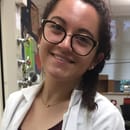I never knew much about art. The renaissance was a word I didn’t know how to spell, Versailles was where they signed a treaty, and da Vinci had a code that Dan Brown wrote about. I got bored at museums, and my favorite paintings were always portraits of fancy ladies with feathered hats. I was impressed by anyone who could paint or draw a passable representation of real life, and I loved seeing work my friends produced. My lack of knowledge didn’t make me feel bad because I felt like I could appreciate “good” art, and let’s be honest, a person can’t know everything.
When I decided to take art history at Kenyon, it was because I needed to fulfill my fine arts requirement. Honestly, I was going to be taking two 300 level English classes and another challenging course, so I couldn’t devote the time needed for a class like Drawing or music theory. The intro art history courses, I was told, were just memorization. They were interesting and fully manageable. Confident in my ability to retain names and dates, I signed up for survey two.
I’m sorry to say that this isn’t an article about my life, or major, changing. This is just to say (William Carlos William’s reference; look it up) that I’ve been surprised at how my usual discipline interacts with this one. Looking analytically at a piece of literature uses similar tools that art historians do when looking at art; the terms are just different. Third person omniscient becomes chiaroscuro and so on. Historical context is crucial, both in terms of the events that were happening when the piece was created and the pieces that predate or follow it.
I didn’t expect any of the pieces that we looked at to inspire a reaction in me to the magnitude that Middlemarch or Emily Dickinson did. Yet, the further we went in the class, the more I found my opinions developing. The way we described how the areas of high polishing focused your attention on Michelangelo’s “Pieta,” is similar to how Dickinson’s dashes make you reconsider the ends of lines. The rounded bodies of Adam and Eve at the peripheries of Jan Van Eyck’s “Ghent Altarpiece” guide your gaze the way the epigraphs at the beginning of each Middlemarch chapter help you prepare for the chapter.
When we look at art, visual or in words, we’re trying to make connections. Analysis is paying attention to the details and trying to figure out why your brain does what it does. Where does your eye go and why does it go out the window instead of staying on the central figure?
I’ve learned more about Christian narratives here than anywhere else, more than in anything I’ve read. Something about Bernini’s “Ecstasy of Saint Teresa” communicates more about spiritual, saintly experience than some written accounts do. The curve and carve of the marble and the way the figures are suspended in space evokes the extremity of the narrative.
Now I know what to look for; I know how to see the light and where it meets the shade. What continues to surprise me is how my disposition to think in metaphors, phrases, and stanza length, helps me understand the art we look at in class. Composition is syntax and saturation of color is like the clarity of a comparison. Not to be a classic liberal arts kid, but if nothing else, this class is teaching me that it always helps to learn more.


